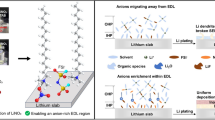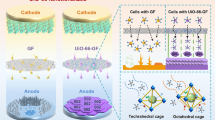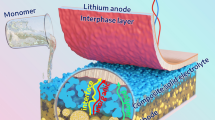Abstract
Ta2O5 nanoparticles (NPs) are one of the exemplary anode materials for a lithium-ion battery which undergoes the conversion-type electrochemical reaction with extrinsic pseudocapacitance. Ta2O5 NPs have been synthesized using the ionic liquid–assisted hydrothermal method. The prepared mesoporous Ta2O5 NPs were characterized using XRD, Raman, TEM, and BET surface area analysis. XRD pattern of prepared Ta2O5 NPs exhibited an orthorhombic crystal structure with an average crystallite size of 30 nm. The BET specific surface area and average pore diameter of Ta2O5 NPs were found to be 23.11 m2/g and 21 nm respectively. TEM images showed the particle-like structure with an average particle size of 25 nm. Ta2O5 NPs show excellent performance with a reversible capacity of 190 mAh g−1 even after 150 cycles at C/10 current rate. Therefore, Ta2O5 NPs could be the prospective contestant as a anode material for the lithium-ion battery.








Similar content being viewed by others
References
Yoshino A (2012) The birth of the lithium-ion battery. Angew Chem Int Ed 51:5798–5800
Goodenough JB, Park KS (2013) The Li-ion rechargeable battery: a perspective. J Am Chem Soc 135:1167–1176
Dunn B, Kamath H, Tarascon JM (2011) Electrical energy storage for the grid: a battery of choices. Science 334:928–935
Liu K, Liu Y, Lin D, Pei A, Cui Y (2018) Materials for lithium-ion battery safety. Sci Adv 4:eaas9820
Zeng X, Li M, Abd El-Hady D, Alshitari W, Al-Bogami AS, Lu J, Amine K (2019) Commercialization of lithium battery technologies for electric vehicles. Adv Energy Mater 9:1900161
Lu J, Chen Z, Ma Z, Pan F, Curtiss LA, Amine K (2016) The role of nanotechnology in the development of battery materials for electric vehicles. Nat Nanotechnol 11:1031
Liu Y, Zhu Y, Cui Y (2019) Challenges and opportunities towards fast-charging battery materials. Nat Energy 4:540–550
Li W, Liu J, Zhao D (2016) Mesoporous materials for energy conversion and storage devices. Nat Rev Mater 1:16023
Mahmood N, Tang T, Hou Y (2016) Nanostructured anode materials for lithium ion batteries: progress, challenge and perspective. Adv Energy Mater 6:1600374
Lu Y, Yu L, Lou XWD (2018) Nanostructured conversion-type anode materials for advanced lithium-ion batteries. Chem 4:972–996
Reddy M, Subba Rao G, Chowdari B (2013) Metal oxides and oxysalts as anode materials for Li ion batteries. Chem Rev 113:5364–5457
Liu Z, Yu Q, Zhao Y, He R, Xu M, Feng S, Li S, Zhou L, Mai L (2019) Silicon oxides: a promising family of anode materials for lithium-ion batteries. Chem Soc Rev 48:285–309
Subhan A, Oemry F, Khusna SN, Hastuti E (2019) Effects of activated carbon treatment on Li4Ti5O12 anode material synthesis for lithium-ion batteries. Ionics 25:1025–1034
Augustyn V, Simon P, Dunn B (2014) Pseudocapacitive oxide materials for high-rate electrochemical energy storage. Energy Environ Sci 7:1597–1614
Augustyn V, Come J, Lowe MA, Kim JW, Taberna P-L, Tolbert SH, Abruña HD, Simon P, Dunn B (2013) High-rate electrochemical energy storage through Li+ intercalation pseudocapacitance. Nat Mater 12:518
Simon P, Gogotsi Y, Dunn B (2014) Where do batteries end and supercapacitors begin? Science 343:1210–1211
Brezesinski K, Wang J, Haetge J, Reitz C, Steinmueller SO, Tolbert SH, Smarsly BM, Dunn B, Brezesinski T (2010) Pseudocapacitive Contributions to charge storage in highly ordered mesoporous group V Transition metal oxides with iso-oriented layered nanocrystalline domains. J Am Chem Soc 132:6982–6990
Sun H, Mei L, Liang J, Zhao Z, Lee C, Fei H, Ding M, Lau J, Li M, Wang C, Xu X (2017) Three-dimensional holey-graphene/niobia composite architectures for ultrahigh-rate energy storage. Science 356:599–604
Huang H, Wang X, Tervoort E, Zeng G, Liu T, Chen X, Sologubenko A, Niederberger M (2018) Nano-sized structurally disordered metal oxide composite aerogels as high-power anodes in hybrid supercapacitors. ACS Nano 12:2753–2763
Son Y, Ma J, Kim N, Lee T, Lee Y, Sung J, Choi SH, Nam G, Cho H, Yoo Y, Cho J (2019) Quantification of pseudocapacitive contribution in nanocage-shaped silicon–carbon composite anode. Adv Energy Mater 9:1803480
Lou S, Cheng X, Wang L, Gao J, Li Q, Ma Y, Gao Y, Zuo P, Du C, Yin G (2017) High-rate capability of three-dimensionally ordered macroporous T-Nb2O5 through Li+ intercalation pseudocapacitance. J Power Sources 361:80–86
Fu ZW, Huang F, Chu YQ, Zhang Y, Qin QZ (2003) Characterization of amorphous Ta2O5 film as a novel anode material. J Electrochem Soc 150:A776–AA82
Zhang P, Zhang J, Gong J (2014) Tantalum-based semiconductors for solar water splitting. Chem Soc Rev 43:4395–4422
Wang B, Huang W, Chi L, Al-Hashimi M, Marks TJ, Facchetti A (2018) High-k gate dielectrics for emerging flexible and stretchable electronics. Chem Rev 118:5690–5754
Cherevan AS, Robbins S, Dieterle D, Gebhardt P, Wiesner U, Eder D (2016) Ordered gyroidal tantalum oxide photocatalysts: eliminating diffusion limitations and tuning surface barriers. Nanoscale 8:16694–16701
Naveenraj S, Lee GJ, Anandan S, Wu JJ (2015) Nanosized tantala based materials – synthesis and applications. Mater Res Bull 67:20–46
Yu X, Li W, Li Z, Liu J, Hu P (2017) Defect engineered Ta2O5 nanorod: one-pot synthesis, visible-light driven hydrogen generation and mechanism. Appl Catal B Environ 217:48–56
Xia S, Ni J, Savilov SV, Li L (2018) Oxygen-deficient Ta2O5 nanoporous films as self-supported electrodes for lithium microbatteries. Nano Energy 45:407–412
Tu H, Xu L, Mou F, Guan J (2016) Highly active Ta2O5 microcubic single crystals: facet energy calculation, facile fabrication and enhanced photocatalytic activity of hydrogen production. J Mater Chem A 4:16562–16568
Nagaraju G, Karthik K, Shashank M (2019) Ultrasound-assisted Ta2O5 nanoparticles and their photocatalytic and biological applications. Microchem J 147:749–754
Dupont J (2011) From molten salts to ionic liquids: a “nano” journey. Acc Chem Res 44:1223–1231
Gao M-R, Yuan J, Antonietti M (2017) Ionic Liquids and poly(ionic liquid)s for morphosynthesis of inorganic materials. Chem Eur J 23:5391–5403
Nagaraju G, Udayabhanu SJP, Manjunath K, Dupont J (2018) Ionothermal synthesis of TiO2 nanoparticles for enhanced photocatalytic H2 generation. Int J Hydrog Energy 43:4028–4035
Hayes R, Warr GG, Atkin R (2015) Structure and nanostructure in ionic liquids. Chem Rev 115:6357–6426
Souza VS, Scholten JD, Weibel DE, Eberhardt D, Baptista DL, Teixeira SR, Dupont J (2016) Hybrid tantalum oxide nanoparticles from the hydrolysis of imidazolium tantalate ionic liquids: efficient catalysts for hydrogen generation from ethanol/water solutions. J Mater Chem A 4:7469–7475
Jana MK, Rajendra HB, Bhattacharyya AJ, Biswas K (2014) Green ionothermal synthesis of hierarchical nanostructures of SnS2 and their Li-ion storage properties. CrystEngComm 16:3994–4000
Li Z, Jia Z, Luan Y, Mu T (2008) Ionic liquids for synthesis of inorganic nanomaterials. Curr Opinion Solid State Mater Sci 12:1–8
He Z, Alexandridis P (2015) Nanoparticles in ionic liquids: interactions and organization. Phys Chem Chem Phys 17:18238–18261
Pan L, Huang H, Liu T, Niederberger M (2019) Structurally disordered Ta2O5 aerogel for high-rate and highly stable Li-ion and Na-ion storage through surface redox pseudocapacitance. Electrochim Acta 321:134645
Manukumar KN, Kishore B, Manjunath K, Nagaraju G (2018) Mesoporous Ta2O5 nanoparticles as an anode material for lithium ion battery and an efficient photocatalyst for hydrogen evolution. Int J Hydrog Energy 43:18125–18135
Roth R, Waring J, Parker H (1970) Effect of oxide additions on the polymorphism of tantalum pentoxide. IV. The system Ta2O5-Ta2WO8. J Solid State Chem 2:445–461
Condon JB. (2006) Surface area and porosity determinations by physisorption: measurements and theory. Elsevier
Park GC, Seo TY, Park CH, Lim JH, Joo J (2017) Effects of calcination temperature on morphology, microstructure, and photocatalytic performance of tio2 mesocrystals. Ind Eng Chem Res 56:8235–8240
Dobal PS, Katiyar RS, Jiang Y, Guo R, Bhalla AS (2000) Raman scattering study of a phase transition in tantalum pentoxide. J Raman Spectrosc 31:1061–1065
Joseph C, Bourson P, Fontana MD (2012) Amorphous to crystalline transformation in Ta2O5 studied by Raman spectroscopy. J Raman Spectrosc 43:1146–1150
Gogotsi Y, Penner RM (2018) Energy storage in nanomaterials – capacitive, pseudocapacitive, or battery-like? ACS Nano 12:2081–2083
Funding
The authors immensely thank ISRO-RESPOND (Project No. ISRO/RES/3/661/2014-15 Dated 14-07-2014) Govt. of India for sanctioning the project and financial assistance. The authors also thank DST Nanomission, Govt. of India, New Delhi for financial support. (No.SR/NM/NS-1262/2013 (G) dated 18-03-2015).
Author information
Authors and Affiliations
Corresponding author
Additional information
Publisher’s note
Springer Nature remains neutral with regard to jurisdictional claims in published maps and institutional affiliations.
Electronic supplementary material
ESM 1
(DOC 115 kb)
Rights and permissions
About this article
Cite this article
Manukumar, K.N., Viswanatha, R. & Nagaraju, G. Ionic liquid–assisted hydrothermal synthesis of Ta2O5 nanoparticles for lithium-ion battery applications. Ionics 26, 1197–1202 (2020). https://doi.org/10.1007/s11581-019-03264-2
Received:
Accepted:
Published:
Issue Date:
DOI: https://doi.org/10.1007/s11581-019-03264-2




